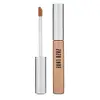What's inside
What's inside
 Key Ingredients
Key Ingredients

 Benefits
Benefits

 Concerns
Concerns

 Ingredients Side-by-side
Ingredients Side-by-side

Water
Skin ConditioningHydrogenated Polyisobutene
EmollientIsononyl Isononanoate
EmollientPropanediol
SolventGlycerin
HumectantPolyglyceryl-3 Polyricinoleate
EmulsifyingPolyglyceryl-3 Diisostearate
EmulsifyingDisteardimonium Hectorite
StabilisingSorbitan Isostearate
EmulsifyingMagnesium Sulfate
Sodium Dehydroacetate
PreservativeCaprylyl Glycol
Emollient1,2-Hexanediol
Skin ConditioningMagnesium Stearate
Cosmetic ColorantTocopheryl Acetate
AntioxidantSodium Lauroyl Glutamate
Lysine
Skin ConditioningMagnesium Chloride
Sodium Hyaluronate
HumectantCassia Angustifolia Seed Polysaccharide
Skin ConditioningCentella Asiatica Extract
CleansingLactobacillus Ferment Lysate
Skin ConditioningCamellia Sinensis Leaf Extract
AntimicrobialPunica Granatum Bark/Fruit Extract
AntimicrobialLactobacillus Ferment
Skin ConditioningCaffeine
Skin ConditioningCI 77002
Cosmetic ColorantCI 77891
Cosmetic ColorantIron Oxides
Water, Hydrogenated Polyisobutene, Isononyl Isononanoate, Propanediol, Glycerin, Polyglyceryl-3 Polyricinoleate, Polyglyceryl-3 Diisostearate, Disteardimonium Hectorite, Sorbitan Isostearate, Magnesium Sulfate, Sodium Dehydroacetate, Caprylyl Glycol, 1,2-Hexanediol, Magnesium Stearate, Tocopheryl Acetate, Sodium Lauroyl Glutamate, Lysine, Magnesium Chloride, Sodium Hyaluronate, Cassia Angustifolia Seed Polysaccharide, Centella Asiatica Extract, Lactobacillus Ferment Lysate, Camellia Sinensis Leaf Extract, Punica Granatum Bark/Fruit Extract, Lactobacillus Ferment, Caffeine, CI 77002, CI 77891, Iron Oxides
Water
Skin ConditioningAloe Barbadensis Leaf Juice
Skin ConditioningPersea Gratissima Fruit Extract
EmollientCetyl Alcohol
EmollientCaprylic/Capric Triglyceride
MaskingGlycerin
HumectantCetearyl Alcohol
EmollientCrithmum Maritimum Extract
Skin ConditioningTocopheryl Acetate
AntioxidantLecithin
EmollientSilica
AbrasiveXanthan Gum
EmulsifyingKaolin
AbrasiveIron Oxides
Titanium Dioxide
Cosmetic ColorantPotassium Sorbate
Preservative
 Reviews
Reviews

Ingredients Explained
These ingredients are found in both products.
Ingredients higher up in an ingredient list are typically present in a larger amount.
Glycerin is already naturally found in your skin. It helps moisturize and protect your skin.
A study from 2016 found glycerin to be more effective as a humectant than AHAs and hyaluronic acid.
As a humectant, it helps the skin stay hydrated by pulling moisture to your skin. The low molecular weight of glycerin allows it to pull moisture into the deeper layers of your skin.
Hydrated skin improves your skin barrier; Your skin barrier helps protect against irritants and bacteria.
Glycerin has also been found to have antimicrobial and antiviral properties. Due to these properties, glycerin is often used in wound and burn treatments.
In cosmetics, glycerin is usually derived from plants such as soybean or palm. However, it can also be sourced from animals, such as tallow or animal fat.
This ingredient is organic, colorless, odorless, and non-toxic.
Glycerin is the name for this ingredient in American English. British English uses Glycerol/Glycerine.
Learn more about GlycerinTocopheryl Acetate is AKA Vitamin E. It is an antioxidant and protects your skin from free radicals. Free radicals damage the skin by breaking down collagen.
One study found using Tocopheryl Acetate with Vitamin C decreased the number of sunburned cells.
Tocopheryl Acetate is commonly found in both skincare and dietary supplements.
Learn more about Tocopheryl AcetateWater. It's the most common cosmetic ingredient of all. You'll usually see it at the top of ingredient lists, meaning that it makes up the largest part of the product.
So why is it so popular? Water most often acts as a solvent - this means that it helps dissolve other ingredients into the formulation.
You'll also recognize water as that liquid we all need to stay alive. If you see this, drink a glass of water. Stay hydrated!
Learn more about WaterThis ingredient is a combination of red, black, and yellow iron oxide pigments. This combination of colors is usually found in foundation, because it results in a "skin" color.